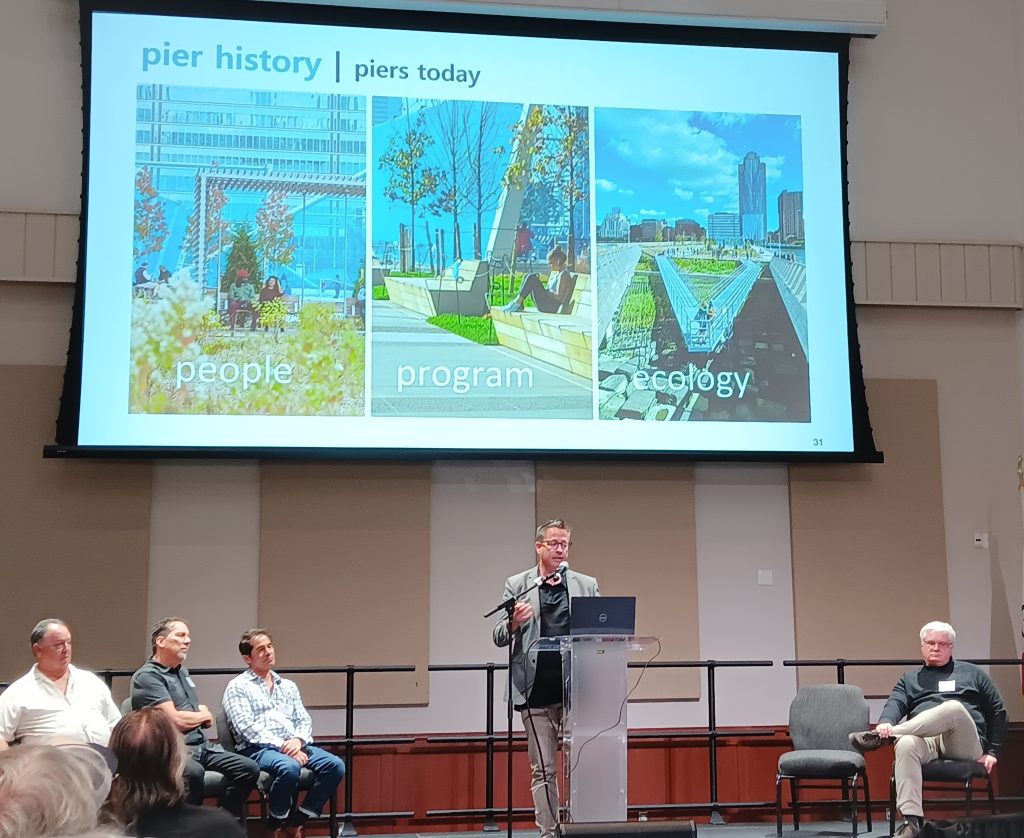
City officials received public testimony on what amenities residents would ideally like to see with a new Ocean Beach Pier, which will be compiled and factored into later decisions made to replace the 56-year-old iconic structure.
City staff and engineering consultants on June 10 shared public input so far on the Ocean Beach Pier Renewal Project, while receiving new input during the second in a series of community workshops aimed at building a new OB Pier.
“Today’s event is really about getting more feedback from you about what type of amenities you would be interested in that would be possible for a new pier,” said James Nagelvoort, director for the City’s Strategic Capital Projects Department.
He noted “the pier took some damage from winter storms,” while adding the good news is “the pier’s underneath structure, the part that holds the pier up, is sound. However, some of the surface railings have been knocked down and the bait shop has taken some damage. Work has started to make those repairs, and we anticipate reopening the pier sometime this July.”
But Nagelvoort warned that OB Pier “will not last another 50 years. We still need to talk about a new pier.”
Matthew Martinez with consultant Moffatt & Nichol, which designs piers and waterfront facilities worldwide, said the design phase for OB Pier replacement is about a two-year process. He added the end result will be a “design-build set of specifications and drawings to go out to bid for contractors.”
Martinez pointed out there is an extensive environmental review and permitting process running concurrently for pier replacement. He added the City’s Historical Resources Board will also have a hand in determining “what we can or cannot do” in terms of pier development.
“We’re going to need to make it (pier) higher to get it out of the waves,” said Martinez, noting better materials will be used in the pier redo to give it longer longevity “allowing more people on the pier more of the time.”
Martinez estimated the cost of pier replacement at $50 million to $70 million. “You’ll have an opportunity to weigh in as to what type of amenities – restaurants, shops, educational areas, gathering spaces – you would like on the pier, all of which could add to the cost,” Martinez concluded.
Based on the findings of a 2018 study, the City has determined that pursuing a potential replacement of the pier is the best option considering the ongoing costs of repairs, the need to modernize the existing facility, and the anticipation of future sea-level rise.
The 2018 study by consultants Moffatt & Nichol examined the damage and deterioration of the structure and analyzed three options for the future of the pier: repair, rehabilitate, or replace. The study documented various structural problems with the pier and determined that it has reached the end of its service life.
Ongoing public workshops will help Moffatt & Nichol design the preferred alternative for the potential replacement of the pier based on input from San Diegans considering community impacts, environmental permitting, sustainability, operational usage, cost, historical significance, and other factors.
The project is currently in the preliminary engineering and planning phase to develop the full scope of a preferred alternative for the potential replacement of the pier. The project still needs to go through other phases including California Environmental Quality Act and National Environmental Policy Act permitting, other regional agency permitting, design, and construction. The preliminary engineering and planning phase is expected to be completed this fall.
After the preferred alternative is completed, a detailed project schedule and cost estimate will be prepared. Currently, there is $8.4 million in state funding designated for the project and the City will pursue other state and federal grants.
A best-case scenario would be to have construction on a new structurally modern pier beginning before the end of 2026, with completion by mid-2028.
OB PIER FACTS
- Originally named the San Diego Fishing Pier. The original plaque is still there.
- Over 500,000 visitors per year.
- At 1,971 feet it is the longest concrete pier on the West Coast. The Pier at Santa Cruz is 2,745 feet, making it the longest in the state.
- Was officially christened and introduced to San Diegans on July 2, 1966. Over 7,000 of San Diego’s then 600,000 residents showed up to celebrate the opening, including local politicians Mayor Frank Curran and Gov. Edmund G. “Pat” Brown who had the honor of cutting the ribbon.
- Although the pier quickly became a popular destination for locals and tourists, its original purpose was for fishing. With the construction of the OB Pier, anglers are able to fish in 25-30 feet of water, avoiding most of the shoreline kelp and enabling them to catch species of fish that live in deeper waters.
- Currently, no fishing license is required on the pier.













Discussion about this post